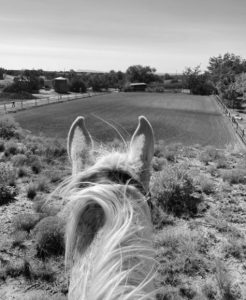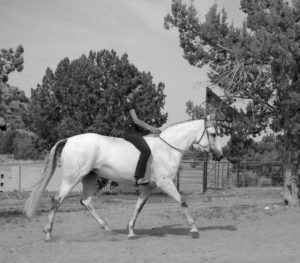Editor’s Note: Best Horse Practices Summit presenter Katrin Silva grew up riding dressage in Germany before moving to the United States at age 19 to learn to ride Western. She’s been riding both disciplines for the last 20 years and is a regular guest columnist for Cayuse Communications. The author of Dressage for All of Us: How to Help Any Horse Become a Happier, More Responsive Riding Partner lives in New Mexico where she works with dressage and Western clients.
Katrin’s upcoming book is Riding with Feel: A Guide for the Rest of Us, due in Summer 2022. Read more about that here.
 Katrin writes:
Katrin writes:
Riding horses is a two-way conversation. The technical knowledge of how to talk to your horse, about what you want him to do, is one part of this process. The other more important part consists of listening to the horse’s side of the story. It’s our willingness and ability to understand what the horse is saying to us at any given moment. This is what we call feel.
All good riding consists of three elements: feel, plus an effective seat, plus a coherent system of aids. Together, these create the alchemy we strive for, the effortless harmony between horse and rider. Developing a good seat is a life-long endeavor. Learning which aids to give when, which movements to ask for and why, takes years of studying different riding traditions along with equine anatomy and biomechanics. Seat and correct aids are what makes horsemanship so complicated.
Feel is easy in comparison. Feel is the simple part of good riding. It’s not rocket science. It does not take any great skill, an expensive upper-level dressage horse, mysterious innate talent, or lessons from a famous clinician. What it does require is lots of time on and around horses, plus a set of physical, mental, and emotional conditions that allow feel to develop (much more about these in my upcoming book). One of the most important factors is a shift from asking to receiving, from doing something to the horse to simply being with the horse, open to his suggestions.
 Riding with feel means listening to what our horses are telling us. It means adjusting what we do, based on the feedback we get from the horse’s behavior, body language, and expression. It means connecting to the horse’s back through our seat and tapping into the information flowing through the horse’s spine. It means feeling the horse’s body with our body, the horse’s mind with our mind.
Riding with feel means listening to what our horses are telling us. It means adjusting what we do, based on the feedback we get from the horse’s behavior, body language, and expression. It means connecting to the horse’s back through our seat and tapping into the information flowing through the horse’s spine. It means feeling the horse’s body with our body, the horse’s mind with our mind.
Most of us don’t have any trouble with the active part of good horsemanship. Doing comes more easily to us than being because our culture has conditioned us that way. We’ve been led to believe that good leadership requires talking a lot, in a loud voice, mostly in imperatives. We‘ve learned that success requires constant effort and that we will reach our goals as long as we pursue them with relentless determination. It seems natural to do more when we’re riding if we are serious about wanting to improve our horsemanship.
Learn more about the Doing Mind versus Being Mind and getting to the Wise Mind.
I’ve taken lots of dressage lessons that confirm this notion. When a horse is slow to respond to a rider’s aids, many instructors start barking phrases that begin with “More!”
 More leg
More leg
More half-halt
More contact
More effort
More seat
More everything
Riders learn that doing more is always the answer, especially if their horse seems sluggish or unmotivated. But if we do too much, too much of the time, we can’t feel. We deprive ourselves the opportunity to hear the horse’s side of the conversation. The horse might say:
I don’t understand.
I am trying, but my back hurts.
I am bored.
I am scared.
Based on this information, we can and should change our approach. We can add stretches and suppling exercises or vary our routine. We can break our request into smaller pieces and help the horse understand these separate elements before combining them again. We will very likely achieve more than we would by kicking harder, pulling harder, or becoming frustrated with the horse.
First, we must take that pause. We have to stop and listen. It may seem counterintuitive, but often, the answer is doing less to accomplish more. Many of us must learn, or re-learn, to just be with our horses, without constantly asking for something.
Of course, just being with our horses is not enough if we want them to become balanced, confident riding partners. Of course, we need to give our horses direction and guidance. Horses like clarity. So we adjust what we tell them, according to what they tell us.
The tricky part of becoming a rider with feel is to shift back and forth between feeling and aiding, between listening and talking, between passively absorbing and actively suggesting. The tricky part is to shift back and forth between doing and being. We tend to get stuck in our doing mode which keeps us from feeling. Let’s try to build those pauses of being and listening. Let’s try to be more and do less. Our horses will thank us for letting them join the conversation.
Good thoughts, as always. I’ve learned more about feel on the ground than in the saddle.
Thank you, Kerry. I’ve heard this a lot, and I’ve learned a lot about feel from the ground, too. But, at least for me, riding takes feel to another level. There is nothing quite like feeling the horse with one’s entire body and mind, the unfiltered communication between the horse’s back and my own.